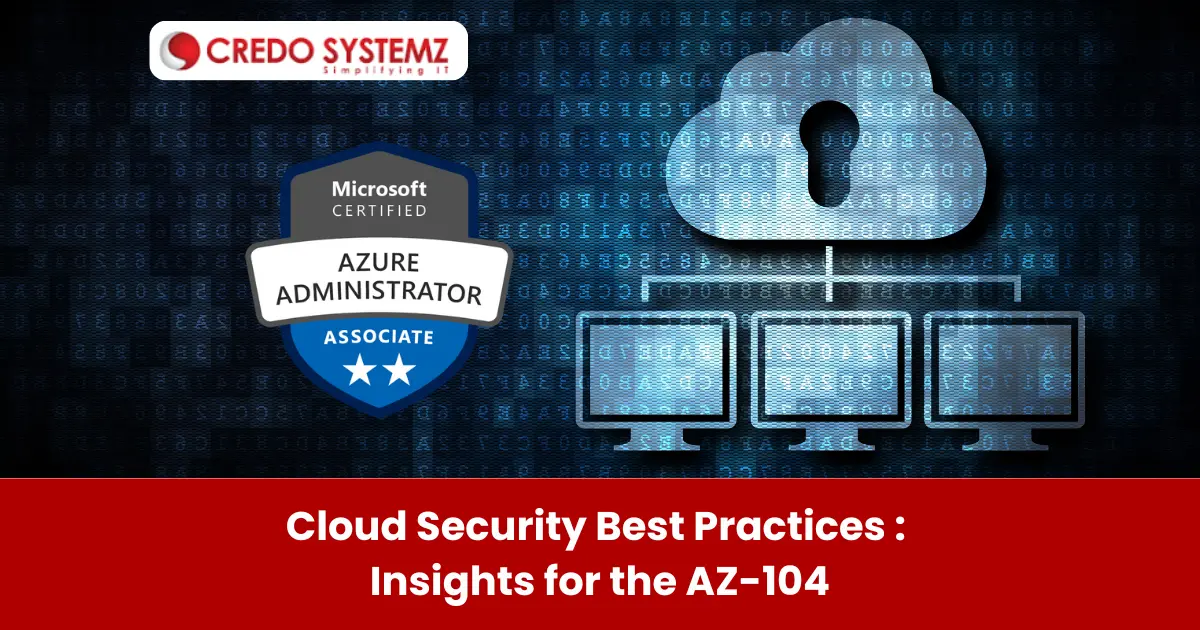
Introduction
As the dominance of cloud computing increases in the IT landscape, cloud security has become a critical component to protect the sensitive data, applications, and infrastructure. Microsoft Azure is one of the leading cloud service platforms that offers numerous services and tools to boost security. To gain the AZ-104: Microsoft Azure Administrator Associate certification, understanding cloud security is the essential best practice. This article explores the key cloud security principles and how to align with the AZ-104 exam.
Shared Responsibility Model
The security responsibilities are divided between the cloud provider and the customer in the cloud environment. Microsoft is responsible for the security of the cloud. Azure customers are responsible for securing the data, operating systems, applications, and configurations. It is the shared responsibility model of Azure. This is the fundamental understanding for the AZ-104 exam. It emphasizes the importance of securing services within the control, such as virtual machines, networking, and identity management.
Implementing Strong Identity and Access Management (IAM)
The IAM capabilities of Azure are central to maintaining a secure environment, and managing identities effectively. This is a core component of the AZ-104 exam. Azure Active Directory (AAD) serves as the backbone of identity management in Azure. The Key practices are:
- Multi-Factor Authentication (MFA),
- Role-Based Access Control (RBAC),
- Conditional Access.
MFA is one of the effective ways to protect against credential theft. It adds an extra layer of protection using a second form of authentication. RBAC is used to assign specific permissions to users based on their roles in the organization. It minimizes unnecessary access to critical resources.
Conditional Access allows developers to control access based on specific conditions such as the:
- User’s location,
- User’s device,
- Risk level.
To prepare yourself for the AZ-104 exam, be familiar with configuring users, groups, and roles within Azure Active Directory. Learn to implement MFA, RBAC and Conditional Access policies.
Securing the Virtual Networks (VNets)
The AZ-104 exam expects aspirants to understand how to configure and secure virtual networks and the best practices include are:
- Network Security Groups (NSGs),
- Azure Firewall, Virtual Private Networks (VPNs) and ExpressRoute.
To control the traffic that access the virtual networks, NSGs is used to filter traffic to and from Azure resources. It allows developers to set inbound and outbound rules. Azure Firewall is a fully managed firewall service that offers advanced threat protection for the virtual networks. It helps to monitor, log, and control traffic with rule-based policies. VPNs and ExpressRoute are used to establish secure, encrypted connections between on-premises networks and Azure. It ensure that the data is transferred securely.
In the AZ-104 exam, proficiency of securing virtual networks is mandatory along with the skills of:
- Configuring VNets,
- Peering VNets,
- Creating and applying NSG rules, Deploying Azure Firewalls.
Encryption Best Practices
Encryption is vital for protecting sensitive data in the cloud. Azure offers several options for encryption at rest and in transit: Azure Storage and Azure SQL Database offer Transparent Data Encryption (TDE) by default. It ensure that all data at rest is encrypted without user intervention. Azure uses Transport Layer Security (TLS) to encrypt data traveling across networks. Additionally, Azure Key Vault can manage and control encryption keys, secrets, and certificates centrally. The AZ-104 exam validates the understanding of Azure Key Vault and encryption management across services.
Monitoring and Responding to Security ThreatsEffective cloud security requires continuous monitoring and responding. Azure provides various tools for monitoring and responding to threats, such as:
Azure security center:
This unified infrastructure security management system offers an overview of the security status of the Azure resources. It provides recommendations and alerts when potential vulnerabilities and misconfigurations are detected.Azure Sentinel:
This is cloud-native Security Information and Event Management (SIEM) tool which is used to detect, investigate, and respond to threats using AI and machine learning.Azure Monitor and Log Analytics:
Azure Monitor provides visibility of the resources with its performance and health. Integrating it with Log Analytics to collect and analyze log data for security events and anomalies. Learn to set up Azure Security Center, using Azure Monitor, and configuring alerting and logging to track security events. Backup and Disaster Recovery In any IT environment, business continuity and data protection are crucial. Azure offers robust backup and disaster recovery solutions. Azure Backup service provides automated, secure backups for Azure resources. It ensure that the data is recoverable in the event of an attack, failure and disaster. Azure Site Recovery (ASR) enables disaster recovery by replicating workloads across regions. If the event fails, the applications can fail over to a secondary location and resume operation with minimal disruption. To clear the AZ-104 certification, know how to implement backup solutions and disaster recovery plans.Conclusion
To conclude, the AZ-104 certification exam focuses on the practical aspects of managing and securing Azure environments. By understanding and applying the cloud security best practices, enhance the skills to achieve security and be prepared for the AZ-104 exam. Join Credo Systemz Azure admin training in Chennai to learn identity management and network security to monitoring and disaster recovery. Equip you with the knowledge necessary to confidently manage Azure resources and secure cloud infrastructures effectively.
Join Credo Systemz Software Courses in Chennai at Credo Systemz OMR, Credo Systemz Velachery to kick-start or uplift your career path.
